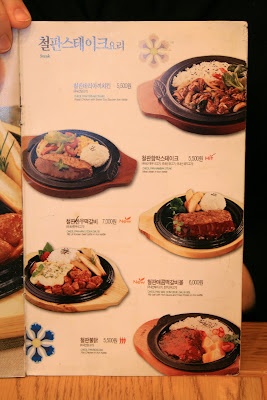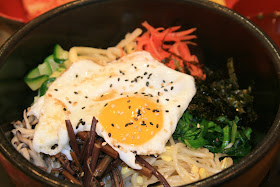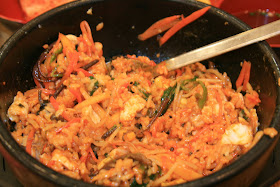 They actually had a menu in English so I did some fast shots of it . . . the quality on a few is not so great, but if you click on the pic and then use the "control +" on the keyboard and zoom in you can read most if not all of the names in Romanized Korean.
They actually had a menu in English so I did some fast shots of it . . . the quality on a few is not so great, but if you click on the pic and then use the "control +" on the keyboard and zoom in you can read most if not all of the names in Romanized Korean.




 Julianne has been in Korea six months and yet still hadn't tried dolsot bibimbap, so we got two orders of it. I think of dolsot (hot stone bowl) bibimbap (stirred mixed rice/meal) as 'the Korean sandwich' of foods. It's so versatile and healthy though that you can eat it for breakfast, lunch, or dinner.
Julianne has been in Korea six months and yet still hadn't tried dolsot bibimbap, so we got two orders of it. I think of dolsot (hot stone bowl) bibimbap (stirred mixed rice/meal) as 'the Korean sandwich' of foods. It's so versatile and healthy though that you can eat it for breakfast, lunch, or dinner.From wikipedia.com,
"A variation of this dish, dolsot bibimbap (돌솥 비빔밥, "dolsot" meaning "stone pot"), is served in a very hot stone bowl in which a raw egg is cooked against the sides of the bowl. The bowl is so hot that anything that touches it sizzles for minutes. Before the rice is placed in the bowl, the bottom of the bowl is coated with sesame oil, making the layer of the rice touching the bowl golden brown and crispy."
 The basic version of this Korean food is called "bibimbap" and it is served cold,
The basic version of this Korean food is called "bibimbap" and it is served cold,"Bibimbap is served as a bowl of warm white rice topped with namul (sautéed and seasoned vegetables) and gochujang (chili pepper paste). A raw or fried egg and sliced meat (usually beef) are common additions. The ingredients are stirred together thoroughly just before eating. It can be served either cold or hot.
Vegetables commonly used in bibimbap include julienned cucumber, zucchini, mu (daikon), mushrooms, doraji (bellflower root), and gim, as well as spinach, soybean sprouts, and gosari (bracken fern stems). Dubu (tofu), either plain or sautéed, or a leaf of lettuce may be added, or chicken or seafood may be substituted for beef. For visual appeal, the vegetables are often placed so that adjacent colors complement each other."
 We also ordered a side dish of "Fusion Ra Boki" which is like dokbokki but with a twist. The menu says it has, "broiled rice cake, noodle, dumplings, fish paste with fruit sauce."
We also ordered a side dish of "Fusion Ra Boki" which is like dokbokki but with a twist. The menu says it has, "broiled rice cake, noodle, dumplings, fish paste with fruit sauce."  Julianne liked it a little bit but said the sauce was "a little strange"--she couldn't quite put her finger on it. I think "tangy" might explain the flavor a little . . . spicy and tangy at the same time. I thought it was pretty good.
Julianne liked it a little bit but said the sauce was "a little strange"--she couldn't quite put her finger on it. I think "tangy" might explain the flavor a little . . . spicy and tangy at the same time. I thought it was pretty good.Whenever I eat dolsot bibimbap I ALWAYS put at least two heaping teaspoons of the spicy red pepper sauce on it and then mix it in. Sometimes restaurants serve you with the sauce already on it and don't give you a small dish with more--I ask for more and always get a shocked reaction because of the stereotype that foreign people can't eat spicy Korean food--NOT true! The Korean co-teachers and other teachers I worked with during my first 3 years in Korea would always totally freak out when I'd start heaping on the red pepper sauce . . . I appreciate their concern but after the 100th time it begins to get a little annoying . . . lol, sigh.
 I forgot to take a pic of Julianne's bowl to contrast the difference in color because she put in a lot less red pepper sauce . . .
I forgot to take a pic of Julianne's bowl to contrast the difference in color because she put in a lot less red pepper sauce . . . If you're new to Korea and haven't walked around the neighborhood you live in yet I'd recommend doing that. Look for small restaurants with orange-colored signs. These are very common in Korea and serve inexpensive healthy everyday Korean foods.
If you're new to Korea and haven't walked around the neighborhood you live in yet I'd recommend doing that. Look for small restaurants with orange-colored signs. These are very common in Korea and serve inexpensive healthy everyday Korean foods. Julianne and I are trying to eat more healthy, and eat more Korean food too. So as we eat more Korean foods I'll blog about them and put up pics too.
J
Thanks for the list of book recommendations!
ReplyDeleteWe've eaten a a Korean BBQ (soooo good), but havent been to any other Korean restaurants. I'm a vegetarian (no meat of any kind or seafood), and I find it hard to find meals without meat, and I dont know how to convey that to a food worker. Any suggestions on meals?